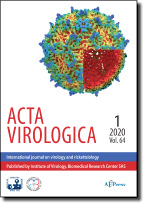Journal info
|
||
Select Journal
Journals
Bratislava Medical Journal Ekologia - Ecology Endocrine Regulations General Physiology and Biophysics Neoplasma Acta Virologica Current articles 2023 2022 2021 2020 2019 2018 2017 2016 2015 2014 2013 2012 2011 2010 2009 2008 2007 2006 2005 2004 2003 Studia Psychologica Cardiology Letters Psychológia a patopsych. dieťaťa Kovove Materialy-Metallic Materials Slovenská hudba 2025Webshop Cart
Your Cart is currently empty.
Info: Your browser does not accept cookies. To put products into your cart and purchase them you need to enable cookies.
Acta Virologica Vol.62, No.3, p.333-336, 2018 |
||
| Title: Quantitative and rapid interference of bovine viral diarrhea virus BVDV/END– and BVDV/END+ strains | ||
| Author: M. MUHSEN, P. LEE | ||
| Abstract: Homologous interference in vitro is defined as the ability of primary viral infection to prevent secondary homologous superinfection. Non-cytopathic bovine viral diarrhea virus (ncp BVDV) has been classified according to the exaltation of Newcastle disease phenomenon (END) as END positive (E+) and END negative (E–) strains. Simultaneous inoculation of MDBK-SY cell monolayers with BVDV/E– virus and a three log higher amount of BVDV RK13/E+ virus, leads to acquisition of the BVDV/E– feature of blocking Newcastle disease virus (NDV) infection in cells. BVDV/E– strains, particularly at a high titre and MOI ≥1.25, can exert and impose their effects in BVDV/E+ infected cells; however, if BVDV/E– MOI is reduced to MOI below 0.625, the BVDV/E+ effect can be restored leading to cytopathic effects (CPE) induction by NDV reciprocal to the titre of the BVDV RK13/E+ strain. Moreover, blocking and prevention of induced CPE by NDV or vesicular stomatitis virus (VSV) occurs even when BVDV/E– superinfects primary BVDV/E+ infected cells, indicating a defective homologous interference between BVDV/E+ and BVDV/E– strains. Taken together, BVDV/E– strains have a strong competitive potency and mediate a fast acting (i.e. within 60 min) influence against BVDV/E+ activity. This may be relevant in vivo where BVDV/E– and BVDV/E+ combinations are frequently isolated from infected individuals. |
||
| Keywords: BVDV; END phenomenon; homologous interference; NDV; VSV | ||
| Published online: 30-Aug-2018 | ||
| Year: 2018, Volume: 62, Issue: 3 | Page From: 333, Page To: 336 | |
| doi:10.4149/av_2018_228 |
||
|
|
 download file download file |
|

